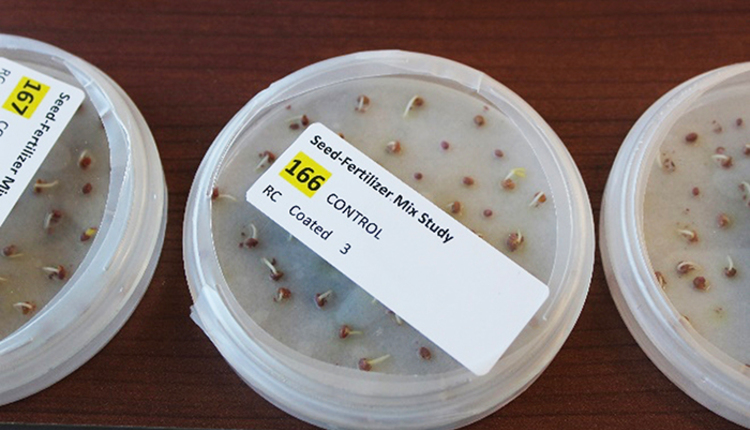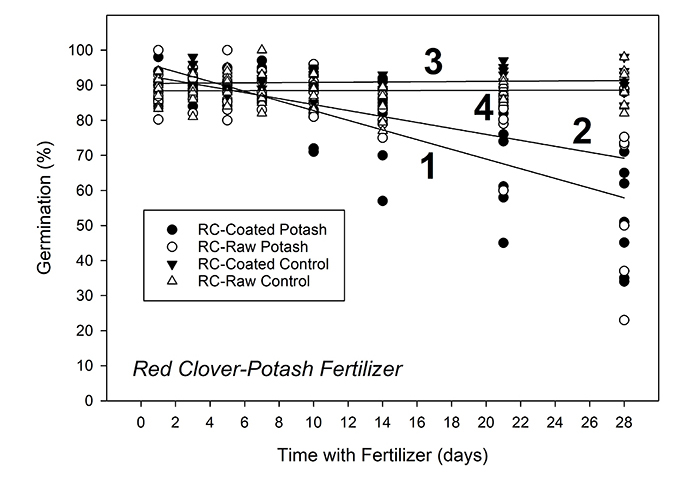
Frost-seeding season has begun, and it can sometimes be tempting to save a trip across the field by mixing the seed with dry fertilizer before broadcasting. Based on research at the University of Kentucky (UK), this might not be a good approach unless the mixture can be spread immediately.
Chris Teutsch, UK’s extension forage specialist, and Edwin Ritchey, an extension soil scientist with UK, initiated a trial looking at the impact on seed germination when mixing muriate of potash (0-0-60) or a blended fertilizer (19-19-19) with red clover seed. Their results were reported at the International Grassland Congress in Covington, Ky., last May.
The trial involved mixing 5 grams of either coated or uncoated red clover seed with 100 grams of one of the two fertilizer types. The mixtures were placed in containers but remained outdoors under a roof. Seed germination was evaluated after 1, 3, 5, 7, 10, 14, 21, and 28 days of fertilizer exposure. There was also a control treatment with seed only (no fertilizer).
Seed germination was determined by extracting seeds using tweezers and placing them in a petri dish lined with wetted filter paper. The entire replicated trial was repeated twice within a week during June 2020. There was no trial by treatment interaction, so the data was combined when reported.
Mixing the red clover seed with the potash fertilizer resulted in a linear decline in seed germination, and this decrease was greater for the seed that was coated (Figure 1). The control treatments did not inhibit germination (Figures 1 and 2). The blended fertilizer resulted in a linear and quadratic decline in seed germination, with the coated seed declining at a greater rate (Figure 2).
Figure 1. Impact of exposure time to muriate of potash (0-0-60) on the germination of raw and coated red clover seed.

Figure 2. Impact of exposure time to blended fertilizer (19-19-19) on the germination of raw and coated red clover seed.

In general, germination was inhibited more by the blended fertilizer than the potash. This was likely due to the hygroscopic nature of the blended fertilizer. The researchers noted that by the end of 28-day period, the seed-blended fertilizer mixture had absorbed enough moisture to become a slurry at ambient temperature and humidity.
Seed coating also caused a greater decline in seed germination for both the potash and blended fertilizer, although the rate of decline was greatest for the blended fertilizer. This was likely due to the seed coating having an enhanced effect on imbibition, leading to higher levels of salt injury. At 21 days of exposure to the blended fertilizer, the germination of the coated seed was near zero compared to the raw seed, which was about 55%.
It's clear from the results of this study that an extended exposure to fertilizer has a detrimental impact on the germination of red clover seed. Fertilizers that are more hygroscopic and using coated seed will enhance this effect.
The researchers did point out that one limitation of this study was the size of the mixed samples, which was quite small compared to an on-farm application. They felt that the small sample unit size likely accelerated the rate of decline in seed germination compared to what might be found in larger piles or loads in spreader trucks.
In the case of larger quantities of seed-fertilizer mixtures, a surface crust would likely form, and that may slow the rate of germination decline in the interior of the pile. Nevertheless, it is still prudent to apply seed-fertilizer mixtures as soon as possible. Afterall, broadcast seeding is already handicapped by a lower germination and establishment percentage compared to drilling seed into the soil.

